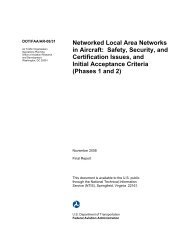Published Report (DOT/FAA/CT-94-36)
Published Report (DOT/FAA/CT-94-36)
Published Report (DOT/FAA/CT-94-36)
Create successful ePaper yourself
Turn your PDF publications into a flip-book with our unique Google optimized e-Paper software.
2.3 BASIC RISK EQUATION<br />
A TCV will occur when two aircraft are aligned in such a way that<br />
a TCV is possible and simultaneously a WCB occurs. Intuition<br />
suffices to prove that an alignment window exists during which a<br />
TCV is possible if a worst case blunder occurs. If the aircraft<br />
are not within this alignment window then the blundering aircraft<br />
would pass harmlessly ahead or behind of the evading aircraft<br />
without any evasive movement of the evading aircraft. Likewise,<br />
it is obvious that a TCV can only occur when a blunder turns into<br />
a worst case blunder. Hence a TCV can only occur when the<br />
aircraft are properly aligned during a blunder which results in a<br />
worst case blunder. In mathematical set theory, this means that<br />
the set of TCV's is a subset of the intersection of the set of<br />
aligned approaches with the set of 30° blunders and the set of no<br />
response blunders.<br />
Although a TCV does not<br />
simplicity and in order<br />
existing accident rate,<br />
in a collision and that<br />
necessarily result in a collision, for<br />
to equate the probability of a TCV to the<br />
it will be assumed that a TCV will result<br />
a collision will result in the loss of<br />
both aircraft. Therefore, in order to simplify the analysis, a<br />
TCV will be assumed to result in two fatal accidents.<br />
Using the notation P(event) to indicate the probability that an<br />
event will occur and P(event 1 I event 2) to indicate the<br />
probability that event 1 will occur given that event 2 has<br />
already occurred, the discussion above indicates that the<br />
probability of a collision may be written as:<br />
P(col1ision) = P(TCV)<br />
= P(TCV and aligned and WCB and blunder)<br />
= P(TCV I aligned and WCB and blunder) x<br />
P(a1igned I WCB and blunder) x<br />
P(WCB I blunder) x P(b1under).<br />
In order to compute the probability of a collision or TCV it is<br />
necessary to compute or estimate four factors. The first factor,<br />
P(TCV I aligned and WCB and blunder) may be estimated from data<br />
collected during the simulation of this study. The simulation<br />
is designed to determine the probability that a TCV will occur<br />
when an aligned WCB occurs. The second factor, P(a1igned 1 WCB<br />
and blunder) may be estimated by analytical means. The third<br />
factor, P(WCB I blunder) is not easily estimated, but bounds may<br />
be placed on its possible variation. The fourth factor,<br />
P(b1under) is even more difficult to estimate since it is<br />
extremely small. Since P(TCV) depends on two factors whose<br />
estimation is in doubt, it is desirable to eliminate at least one<br />
of the doubtful factors. From historical data the probability of<br />
L-3

















